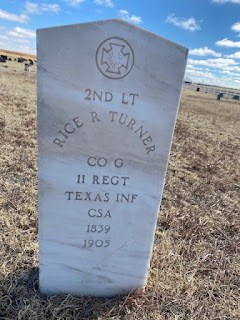Sunday, June 26, 2022
Confederate Veterans Buried at Sayre
by Judy Haught
A stroll
through Lone Oak Cemetery near Sayre, Oklahoma, will reveal the graves of
several veterans, among them a number of graves of Confederate soldiers. A
Confederate grave is easy to spot. The gravestone will have a pointed top and a
Southern Cross of Honor engraved in the stone. Legend has it that Confederate
gravestones have pointed tops to keep Yankees from sitting on them. The
Southern Cross of Honor was originally bestowed to Confederate soldiers as a
medal. It was the Confederate version of the Union Medal of Honor. Later the
United States Veterans Administration issued gravestones for Confederate
veterans with the cross engraved on them. Occasionally a Confederate grave will
also have a metal version of the cross alongside the gravestone.
One of the
Confederate veterans buried at Lone Oak Cemetery is Rice R. Turner. While
details of Turner’s life are sketchy, several facts can be gleaned from U. S.
Census Records, the National Park Service, and Texas history websites. He was
born in Mississippi in 1839. He joined the 11th Confederate Infantry
in Texas on February 26, 1862. Texas seceded from the Union soon after Abraham
Lincoln was elected President in 1861, even before the war officially started.
The 11th Texas Infantry was mustered into service in the winter of
1861-1862 near Houston. Ten companies with recruits from several Texas counties
comprised the regiment. Turner was among those recruits. His rank upon joining
the army was Private, but at the end of his tour of duty, his rank was 2nd
Lieutenant, a fact that indicates a field promotion. A field promotion would
generally be granted for outstanding service in combat, allowing a soldier to
skip the traditional channels of rank and promotion.
According to
the Texas State Historical Association, the 11th Texas Infantry was
stationed in East Texas until August 1862. There the Texas State Penitentiary
at Huntsville furnished the soldiers with “cloth for tents, knapsacks, and for
some clothing.” One wonders if the soldiers had to use the cloth to sew their
own clothes and equipment or possibly hire it done. The regiment went on to
engage in several battles in Louisiana and Arkansas, suffering a large number
of casualties. In the spring of 1864, they participated in the Red River
Campaign in Louisiana. They assisted in the capture of “2,000 prisoners, 20
pieces of artillery, and 200 wagons of arms.” Then in 1865, they guarded
prisoners at Tyler, Texas. The war ended in April 1865 with Robert E. Lee’s
surrender at Appomattox Courthouse, Virginia, and the 11th Texas
Infantry surrendered June 2, 1865, at Galveston, Texas. As a Confederate
soldier, Turner was considered a prisoner of war by the United States. Upon
signing a pledge to never serve in a “military capacity” against the United
States, he was paroled and set free on July 7, 1865, at Marshall, Texas.
After the
war, Turner remained in Texas and married Martha Jane Collier in 1865. The
couple made their home in Pennington, Texas, despite the fact that the
Reconstruction era in Texas was one of anger and tumult. Texas residents had to
take a pledge of loyalty to the United States and profess the illegality of
secession. Many Texas residents, primarily German immigrants and Tejanos, had
been opposed to secession. Violence had erupted in the state over political
disagreements, and old wounds still festered after the war. In addition,
disagreements between Texas and Native Americans that had taken a back seat to
the war rose up again with renewed violence.
Yet Turner
and his family remained. The 1870 U. S. Census lists Turner’s profession as
saddler. The Texas Land Title Abstracts indicates that Turner owned 160 acres
of land in the Nacogdoches District of Angelina County, and the 1880 census
lists him as a farmer. Having a stable, essential vocation could account for
his remaining in Texas. Turner and Martha gave birth to nine children during
the years of 1866 to 1885: John Marshall, William Pickney, Samuel Isham, Mary
Lena, Florence Almarena, Leonidas Earl, Pascal Gustave, Phocion Pericles, and Amelia.
Amelia is listed in the 1870 census but not in the 1880 census, a fact that
could indicate she died during the years between censuses.
A fire
destroyed the 1890 census, so no information on Turner and his family is
available for that year. However, the 1900 census shows him living in Texola
Township, Oklahoma Territory, with his son. Rice Turner died November 22, 1905,
at the age of 65-66. He had received a Confederate Veteran’s pension until his
death, and his wife Martha received a Confederate widow’s pension until she
died December 9, 1923.
Why so many
Civil War veterans moved to Oklahoma Territory is pure conjecture. Some surely
came for opportunity, and others followed adult children. Perhaps some sought
peace beyond the strife of war and reconstruction. Union and Confederate
veterans apparently lived in harmony and even lie near one another in Beckham
County cemeteries.
Sources
“Alabama,
Texas, and Virginia, U.S., Confederate Pensions, 1884-1958.” Ancestry.com
26 June 2022.
“Confederate
SFervice Grave Markers.” Sons of
Confederate Veterans Adam Washington
Ballenger Camp #68. Sons of Confederate Veterans. http://www.schistory.net/scv/markers.htm.
26 June 2022.
“Cross,
Southern Cross of Honor (Confederate States of America)” City of Grove.
http://www.cityofgroveok.gov 26 June 2022.
Derbes,
Brett J. “Eleventh Texas Infantry.” Texas
State Historical Society.
http://www.tshaonline.org/handbook
26 June 2022.
“Rice R.
Turner.” Find a Grave. http://www.findagrave.com
26 June 2022.
“Rice R.
Turner.” Fold 3. Ancestry.com 26 June
2022.
The History of Oklahoma in Fifteen Notable Books by Judy Haught Are you an Oklahoma history buff? Are you looking for a good book? T...
-
The Missiles of Oklahoma This October marks the 60 th anniversary of the Cuban Missile Crisis. And as the world approached the ...




